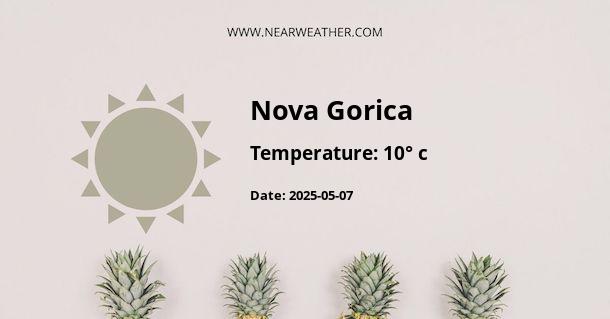Introduction to Mestna Občina Nova Gorica's Climate
Mestna Občina Nova Gorica is a municipality in western Slovenia, near the Italian border. It has a unique climate that is influenced by both the Mediterranean and the Alpine worlds, creating a blend conducive to diverse weather patterns throughout the year. Let's explore the nuanced climate and weather of Nova Gorica, providing insights supported by data and expert analysis.
Geographical Influences on Nova Gorica's Climate
Nova Gorica lies at the confluence of the Soča and Vipava valleys, with the Julian Alps to the north and the Adriatic Sea to the south. This geographical setting plays a pivotal role in shaping its climate, fostering conditions that oscillate between continental and Mediterranean influences.
Seasonal Climate Overview
Nova Gorica experiences a mixed climate where one can witness warm summers, mildly cold winters, and transitional autumns and springs, each bringing its own set of weather patterns.
Spring
- Temperature averages rise from cool to comfortable
- Increased likelihood of rainfalls, especially in April and May
- Spring blossoms bring the countryside to life
Summer
- Warm to hot temperatures, averaging 20-30°C
- Higher humidity with occasional thunderstorms
- Peak tourist season, due to favorable weather
Autumn
- Declining temperature averages
- Harvest season with cooler, often wetter weather
- Stunning fall foliage as nature prepares for winter
Winter
- Snowfall is moderate, with temperatures often hovering around freezing
- Winter sports in nearby mountains are a common attraction
- Though milder than other Alpine regions, cold spells are not uncommon
Temperature and Precipitation Patterns
Data on temperature and precipitation are pivotal when understanding Nova Gorica's climate. To illustrate the monthly variations, we will present this information in a tabular format.
Monthly Temperature and Precipitation Chart
| Month | Average High (°C) | Average Low (°C) | Average Precipitation (mm) |
|---|---|---|---|
| January | 6 | -1 | 70 |
| February | 8 | 0 | 60 |
| March | 12 | 3 | 75 |
| April | 16 | 7 | 100 |
| May | 21 | 11 | 95 |
| June | 25 | 15 | 100 |
| July | 28 | 17 | 80 |
| August | 28 | 17 | 100 |
| September | 24 | 13 | 140 |
| October | 18 | 9 | 170 |
| November | 12 | 5 | 180 |
| December | 7 | 1 | 120 |
These statistics are intended as a general guide and individual years may show significant variation due to the complex interplay of regional climate drivers.
Extreme Weather Events and Climate Anomalies
While Nova Gorica enjoys a relatively moderate climate, it is not immune to extreme weather events and anomalies that are often accentuated by climate change.
- Heatwaves during the summer months have become more frequent and intense.
- Strong Bora winds, a feature of the region, can reach high speeds, especially during winter and autumn.
- Flash floods due to heavy rainfalls are possible during transitional seasons.
The Bora Wind Phenomenon
A unique feature of the local climate is the Bora wind, a cold and dry northeasterly wind that descends from the higher plateau of the Slovenian Karst. Here is what characterizes the Bora wind:
The Bora wind can achieve gusts of over 200 km/h, significantly impacting daily life and the local ecology.
Typical Effects of Bora Winds
- Disrupts maritime and land transport
- Shapes the local agriculture and viticulture practices
- Contributes to the clearness of the air and cooler temperatures
Local Climate Change Trends
Nova Gorica is not exempt from the broader trends of climate change, which affect both the natural environment and human activities.
- Increasing temperatures leading to more severe and prolonged droughts
- Altered precipitation patterns, impacting agriculture and water resources
- Increased incidence of extreme weather events, placing stress on infrastructure
The Impact of Climate on Nova Gorica's Viticulture
Viticulture is an essential aspect of Nova Gorica's cultural and economic landscape. The climate, especially the interplay of warm Mediterranean breezes and the cooler Alpine gusts, makes it particularly suitable for wine production.
- Local grape varieties thrive in the unique blend of climatic conditions
- Temperature fluctuations between day and night contribute to the development of aromatic compounds in grapes
- The Bora wind helps to prevent the spread of vine diseases
Weather and Tourism in Nova Gorica
Nova Gorica's climate is a significant draw for tourists. From its picturesque landscapes to its wine regions, the weather plays a crucial role in the area's tourism appeal.
- Summer attracts tourists to outdoor activities like hiking and cycling
- Autumn is popular for wine tourism, with harvest festivals and tastings
- Winter sports in the nearby Julian Alps peak during the colder months
Conclusion
The climate and weather of Mestna Občina Nova Gorica offer a dynamic and rich tapestry significantly shaped by both Mediterranean and Alpine influences. With careful consideration of these factors, businesses and individuals can plan effectively for diverse activities year-round, from viticulture to tourism.
A - Nova Gorica's Latitude is 45.965199 & Longitude is 13.728050.
A - Weather in Nova Gorica is 4° today.
A - Climate Conditions in Nova Gorica shows scattered clouds today.
A - Humidity in Nova Gorica is 82% today.
A - Wind speed in Nova Gorica is 1.62 km/h, flowing at 31° wind direction. today.
